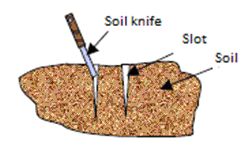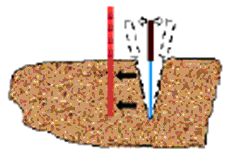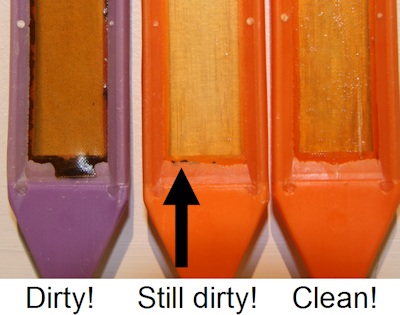Customer Information
Use
- Store in a clean, cool place prior to use. Check every few weeks to ensure the membranes remain moist (some moisture/condensation in the bag, but not sitting in water). If the membranes appear dry (beginning to go taut rather than being wavy), moisten with a small amount of deionized, distilled, or reverse osmosis water. The PRS® Probes can be stored in this way for the duration of one sampling season (6 months to a year). Do not write on, mark or affix labels directly to the PRS probes.
- Make a slot in soil using a soil knife.

- Insert PRS® Probes and then apply a 'back-cut' with a spade or soil knife to ensure good contact between the ion exchange membrane and soil. Close the back-cut holes by firmly pressing the soil with your heel, which prevents water accumulation and further ensures complete contact between the PRS® Probe and soil. Watch the Installation Video.

- Monitor soil moisture and temperature during burial period. For example, determine gravimetric soil moisture and temperature at the beginning and end of the burial period for several representative soil samples from the study area, and obtain daily air temperature maxima and precipitation. Depending on study objectives, competition by plant roots may need to be controlled by periodic severing of roots and/or installation of root exclusion cylinders.
- Leave in soil for pre-determined length of time.
- Remove from soil and wash with deionized, distilled, or reverse osmosis water.
- Do not write on, mark or affix labels directly to the PRS probes.
- Clean PRS® Probes should have NO SOIL on membrane or plastic or in any cracks or corners. The entire PRS® Probe will be eluted in HCl acid and any trace of soil remaining on the PRS® Probe during elution can affect your data. Check the cracks and crevices of the plastic and where plastic meets membrane for soil and rinse it away. Both the plastic and the membrane can be scrubbed vigorously with a scrub brush to remove soil.
- A pressurized washing system is often necessary for effective cleaning (e.g., Hydroshot portable power cleaner with 30 or 45° nozzle, stainless steel keg with air compressor and pressure washer gun).
- PRS® Probes may be transported in a cooler to a cleaning facility.
- It may be necessary to re-wash probes in the lab if not completely clean.


- Place all PRS® Probes from one sample in one clearly and permanently-labeled Ziploc or similar resealable bag.
- Shake excess water off prior to placing in bag.
- The sample bag should not contain soil or dirty water.
- Submit your samples.
